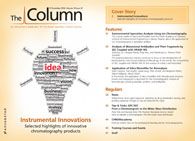Environmental Speciation Analysis Using Ion Chromatography
The Column spoke to Rajmund Michalski from the Polish Academy of Sciences, Institute of Environmental Engineering in Zabrze, Poland, about the application of ion chromatography in speciation analysis.
The Column spoke to Rajmund Michalski from the Polish Academy of Sciences, Institute of Environmental Engineering in Zabrze, Poland, about the application of ion chromatography in speciation analysis.
Q: What are your main research interests?
A. My main research interests cover the application of ion chromatography in environmental, industry, food, and medical research. The main focus of my research group is species analysis of metal/metalloids ions by using hyphenated techniques (HPLC–ICP–MS), and inorganic disinfection by-products of drinking water.

(PHOTO CREDIT: THOMAS VOGEL/GETTY IMAGES)
Q: How has the field of ion chromatography developed since its introduction in 1975? How have these developments affected the field of environmental analysis?
A. Environmental analysis for inorganic anions and cations was historically performed by conventional wet chemical methods that are labour intensive, time-consuming, and occasionally susceptible to interferences. Ion chromatography has become an essential tool for the analytical chemist since it was launched in 1975, especially in the area of anion analysis. In most cases, ion chromatography has replaced conventional wet chemical methods.
Ion chromatography evolved from a relatively simple method used to determine inorganic ions at the level of mg/dm3 concentrations into an elaborate method of separation and determination of organic and inorganic substances at the ultratrace level, including analyses of complex matrix samples. Ion chromatography is currently a well-established, mature technique for the analysis of anions and cations in liquid, gaseous, and solid samples, and many organizations, such as ISO, US EPA, ASTM, and AOAC, base their standards on regulatory methods of analysis using this technique.
The most important challenges related to IC development and applications include: development of new sample preparation methods; improving the speed and selectivity of the analyte separation; lowering limits of detection and quantification; extending the scope of applications of methods and analytical techniques; developing new standard methods; extending the scope of the analysis for new groups of substances; and miniaturization. For that reason, ion chromatography will continue to develop and become an even more valuable tool in the future.
Q: What are the different types of detector that ion chromatography can be coupled with? What are the factors that need to be considered when selecting a detector?
A. Detection methods applied in ion chromatography can be divided into electrochemical and spectrometric methods. Electrochemical detection methods include conductometric, amperometric, and potentiometric methods, while spectroscopic methods include molecular techniques (UV–vis, chemiluminescence, fluorescence, and refractive index methods), and spectroscopic techniques such as atomic absorption spectrometry (AAS), atomic emission spectrometry (AES), inductively coupled plasma–optical emission spectrometry (ICP–OES), inductively coupled plasma–mass spectrometry (ICP–MS), and mass spectrometry (MS).
When choosing appropriate detection conditions for specific analytes, several factors should be taken into account. These factors include: type and concentration of the species to be analyzed, required resolution and method precision, speed and cost of analysis, and the potential for automation. The most widespread detection technique in ion chromatography is still conductometry because electric conductivity of electrolytes is strongly dependent on concentration. However, all other methods can be used.
The most powerful detection technique for the trace analysis for complex matrices is mass spectrometry, separately or combined with an inductively coupled plasma source or an electrospray source. It offers information on the quantitative and qualitative sample composition and helps to determine analyte structure and molar masses. The access to the structural data (necessary for the identification of the already known or newly-found compounds) poses a challenge for speciation analysis as higher sensitivity of detection methods contributes to the increased number of detected element forms.
Q: In a recent study you simultaneously determined inorganic forms of arsenic, antimony, and thallium in river water by performing HPLC–ICP–MS. What is speciation analysis and why is it important?
A. Speciation analysis, which is research into the variety of element forms, is gaining importance in environmental protection, biochemistry, geology, medicine, pharmacy, and food quality control. Speciation analysis is popular because what frequently determines the toxicological properties of a compound or element is not its total content. In many cases, it is the presence of its various forms (for example As[III] or As[V]; Cr[III] or Cr[VI]; Tl[I] or Tl[III]). Studying low analyte concentrations, particularly in complex matrix samples, requires meticulous and sophisticated analytical techniques, such as hyphenated methods, which combine different separation and detection methods.
A proper hyphenated method should be selective towards determined analytes and sensitive in a broad concentration range. It should also possibly allow the best identification of the determined substances. The selection of a hyphenated method should be conditioned by the analyte nature, possible combination of various methods, the required sensitivity of the analysis, and apparatus availability.
The determination and speciation of metals or metalloid ions, such as arsenic, antimony, and thallium species have received significant attention in recent years because of their strong environmental impact. They are particularly interesting as a result of their toxicological properties and types of organic and inorganic forms. Antimony and thallium are elements whose concentrations in surface waters are not regulated. Their concentrations are generally not high, unless it concerns a heavily polluted surface water, such as the Klodnica River which was the object of our research. Many rivers in areas subject to strong anthropogenic impact are places of recreation (bathing) and even fishing.
Q: Why is HPLC–ICP–MS an ideal tool for speciation analysis? What advantages does it offer over other techniques?
A. Even though speciation analysis has made enormous progress in the past 20 years, it is still a relatively new area of analytical chemistry. The development of this approach depends on many factors, such as developing new methods of separation, detection, and sample preparation as well as the availability of new certified reference materials. Hyphenated methods create unprecedented opportunities and their main advantages include extremely low limits of detection and quantification, high precision, and repeatability of analysis.
On the other hand, hyphenated methods have their specific limitations, such as high price and complexity of the apparatus. Consequently, they are not in general laboratory use. The application of hyphenated methods requires a perfect understanding of analytical methodologies and apparatus. Those systems are expensive and used in scientific research, rather than for routine analyses. Nonetheless, the progress in the discussed methods is becoming more and more important and visible as the number of applications and works concerning them is constantly rising.
Q: Where will your research take you in the future? (What are you working on next?)
A. We are currently analyzing other metal and metalloid inorganic species - including manganese, selenium, bismuth, and perchlorate - in environmental samples. In the 19th century, before the rapid development of industry, it was estimated that there was around 300,000 chemical compounds present in the environment. At the beginning of the 21st century, the number of chemical compounds present in the environment exceed 70,000,000. The vast majority of them are chemical compounds of anthropogenic origin. About most of them we know only a little, or only that they can be hazardous for humans. They are present in all parts of environment, including different kinds of water. It has a huge impact on the environment and quality of life.
Arsenic, antimony, thallium, and perchlorate are examples of toxic elements. Their speciation is especially important in the environmental and biomedical fields because of their toxicity, bioavailability, and reactivity. Biochemical and toxicological investigation showed that the chemical form of a specific element or the oxidation state in which that element is introduced into the environment are as important for living organisms as its quantity.
Rajmund Michalski is an Associate Professor and the Deputy Director for Research at the Institute of Environmental Engineering, Polish Academy of Science in Zabrze, Poland. His current research interests include the application of IC, HPLC, and GC for the determination of inorganic and organic compounds in environmental samples, and the application of hyphenated techniques (IC–ICP–MS, IC–MS) in species analysis (water inorganic disinfection by-products, metal/metalloids ions). He has produced over 170 publications on the application of IC in environmental sample analysis, as well as the application of modern analytical techniques for environmental protection and assessment.

Rajmund Michalski
E-mail: rajmund.michalski@ipis.zabrze.pl
Website: http://www.english.pan.pl
This article is from The Column. The full issue can be found here>>

Silvia Radenkovic on Building Connections in the Scientific Community
April 11th 2025In the second part of our conversation with Silvia Radenkovic, she shares insights into her involvement in scientific organizations and offers advice for young scientists looking to engage more in scientific organizations.
Regulatory Deadlines and Supply Chain Challenges Take Center Stage in Nitrosamine Discussion
April 10th 2025During an LCGC International peer exchange, Aloka Srinivasan, Mayank Bhanti, and Amber Burch discussed the regulatory deadlines and supply chain challenges that come with nitrosamine analysis.
Characterizing Plant Polysaccharides Using Size-Exclusion Chromatography
April 4th 2025With green chemistry becoming more standardized, Leena Pitkänen of Aalto University analyzed how useful size-exclusion chromatography (SEC) and asymmetric flow field-flow fractionation (AF4) could be in characterizing plant polysaccharides.












